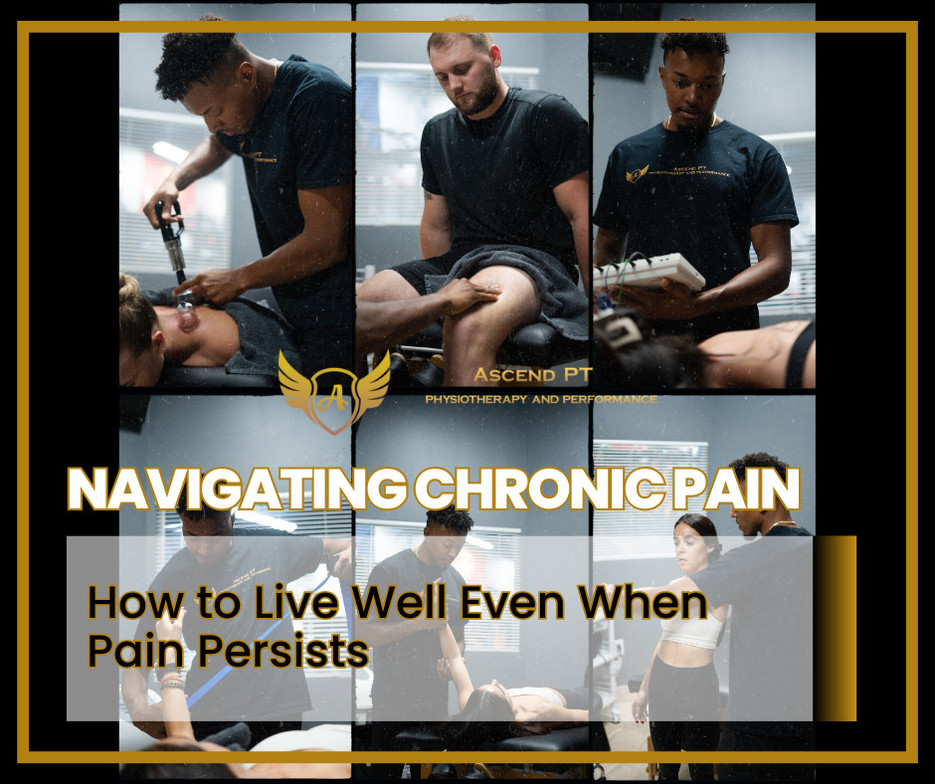
INTRODUCTION
Chronic pain can be an overwhelming and persistent challenge, affecting every aspect of life. At Ascend PT Physiotherapy and Performance, we understand the daily struggles of living with chronic pain, and we're committed to providing support and effective strategies to help you manage discomfort, improve mobility, and maintain a positive outlook. This guide will explore practical approaches to living well with chronic pain and introduce innovative therapies such as Shockwave Therapy that can offer significant relief and enhance your quality of life.
UNDERSTANDING CHRONIC PAIN
Chronic pain is defined as pain that persists for longer than three months, often beyond the expected healing time of an injury or illness. It can result from a variety of conditions, including arthritis, fibromyalgia, or previous injuries, and can lead to a host of physical and emotional challenges. Understanding chronic pain is the first step toward managing it effectively.
1. Developing a Comprehensive Pain Management Plan
Creating a well-rounded pain management plan is crucial for navigating chronic pain. A multifaceted approach addresses both physical and emotional aspects of pain, enhancing overall well-being. Here are key components of an effective plan:a.
- Medical Consultation: Regular consultations with healthcare professionals, including physical therapists and doctors, can help monitor your condition and adjust your treatment plan as needed. They can provide personalized advice on managing pain and recommend appropriate therapies.
- Medication Management: For some, medication may be a necessary part of managing chronic pain. Work closely with your healthcare provider to find the right balance of medications that effectively alleviate pain while minimizing side effects.
- Physical Therapy: Physical therapy is a cornerstone of pain management, focusing on exercises that improve strength, flexibility, and overall function. At Ascend PT Physiotherapy and Performance, our tailored physical therapy programs are designed to address specific pain points and enhance mobility.
2. Incorporating Effective Therapies
In addition to standard pain management techniques, various therapies can provide significant relief. One such therapy is Shockwave Therapy.
- What is Shockwave Therapy? Shockwave Therapy is a non-invasive treatment that uses acoustic waves to stimulate healing in damaged tissues. It promotes blood flow, reduces pain, and enhances the regeneration of tissues. This therapy is particularly effective for conditions such as plantar fasciitis, tendinitis, and chronic muscle pain.
- Benefits of Shockwave Therapy
- Pain Relief: Shockwave Therapy helps reduce pain by targeting the source of discomfort and promoting the body's natural healing processes.
- Enhanced Mobility: By improving tissue repair and reducing stiffness, Shockwave Therapy can lead to increased mobility and improved function.
- Reduced Need for Medication: Effective pain relief through Shockwave Therapy can potentially reduce reliance on pain medications.
- How Shockwave Therapy Works: The procedure involves applying a handheld device to the affected area, where it delivers high-energy acoustic waves. The treatment typically lasts about 15-20 minutes per session, with a series of sessions often recommended for optimal results.
3. Embracing Lifestyle Changes
In addition to medical treatments and therapies, lifestyle changes can play a significant role in managing chronic pain.
- Regular Exercise: Engaging in regular, low-impact exercise can help maintain flexibility, strengthen muscles, and improve overall function. Activities such as swimming, walking, or cycling can be beneficial. It’s essential to consult with your physical therapist to design an exercise routine that suits your condition.
- Healthy Diet: A balanced diet rich in anti-inflammatory foods can support pain management and overall health. Incorporate fruits, vegetables, whole grains, and lean proteins into your diet, while reducing processed foods and excessive sugars.
- Stress Management: Chronic pain can exacerbate stress, which, in turn, can increase pain levels. Techniques such as mindfulness, meditation, and deep breathing exercises can help manage stress and improve your overall sense of well-being.
- Quality Sleep: Adequate and restful sleep is crucial for pain management. Create a sleep-friendly environment and establish a regular sleep routine to ensure you get the restorative rest needed for healing.
4. Maintaining a Positive Outlook
Living with chronic pain can be emotionally challenging. However, maintaining a positive outlook is essential for managing pain and improving quality of life.
- Setting Realistic Goals: Set achievable goals for yourself, both short-term and long-term. Celebrate your progress, no matter how small, and adjust your goals as needed.
- Seeking Support: Connecting with support groups, counseling, or therapy can provide emotional support and practical advice. Sharing experiences with others who understand your situation can be empowering and comforting.
- Focusing on What You Can Control: While chronic pain may limit some activities, focus on what you can control and find new ways to enjoy life. Engage in hobbies, pursue interests, and maintain social connections.
CONCLUSION
Navigating chronic pain requires a comprehensive approach that includes medical management, effective therapies like Shockwave Therapy, lifestyle changes, and a positive mindset. At Ascend PT Physiotherapy and Performance, we are dedicated to helping you live well even when pain persists. Our personalized treatment plans and innovative therapies are designed to support you on your journey to better health and improved quality of life.
Ready to take the next step in managing your chronic pain? Contact us today to schedule a consultation and discover how our services can make a difference in your life.
Dr. Alex Samuel
Contact Me

